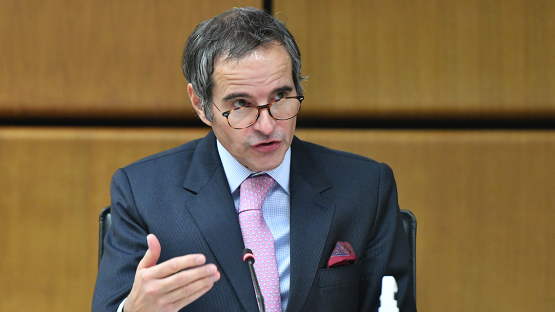
IAEA Director General Rafael Mariano Grossi delivering his opening statement to the IAEA Board of Governors. (D. Calma/IAEA)
North Korea appears to have operated its Yongbyon nuclear reactor, which can produce weapons-grade plutonium, and continued nuclear activities at Kangson and Pyongsan, a UN watchdog revealed Wednesday.
Rafael Mariano Grossi, director general of International Atomic Energy Agency, said Wednesday the continuation of nuclear program is “a clear violation of relevant UN Security Council resolutions and is deeply regrettable.”
The IAEA identified “ongoing indications consistent with the operation of the 5MW(e) reactor at the Yongbyon site,” Grossi revealed at the opening of the board of governors meeting at the IAEA headquarters in Vienna.
Wednesday’s announcement is in line with the IAEA’s latest annual report released in August. The nuclear watchdog previously said there were signs of the resumed operation of the main nuclear reactor in Yongbyon from early July 2021. But the reactor had been shut down from early December 2018 to the beginning of July this year.
The nuclear reactor is the core of North Korea’s plutonium production efforts. Pyongyang can extract plutonium for use in nuclear weapons at the radiochemical laboratory by reprocessing spent nuclear fuel rods obtained from the 5-megawatt reactor.
But notably, the IAEA director general on Wednesday said there were no signs of a new reprocessing campaign.
“There continue to be no indications of the operation of the Radiochemical Laboratory since early July 2021.”
From mid-February to early July, there were signs that the radiochemical laboratory was operating, which is consistent with the time frame to reprocess spent fuel rods.
Grossi also disclosed that the agency “observed new and ongoing construction activities” at the Yongbyon nuclear facility.
Pyongyang’s moves to expand the Yongbyon complex include the construction of a building in the vicinity of the light water reactor, whose presumed purpose is to “support reactor construction or maintenance activities.” The construction of an annex to the centrifuge enrichment facility has been underway, although the IAEA has not yet confirmed the purpose of the facility expansion.
Grossi said the agency also detected ongoing signs of activities at the Pyongsan Uranium Concentration Plant and its associate mine, as well as the Kangson complex on the outskirts of Pyongyang.
The places have been pointed to as essential components of North Korea’s nuclear proliferation.
The Pyongsan Mine and Concentration Plant are believed to be the largest known operating uranium mine and concentration plant as well as the sole publicly acknowledged source of yellowcake or uranium ore. North Korea extracts uranium ore at the Pyongsan mine and turns uranium ore into yellowcake at the Pyongsan plant. Yellowcake or uranium concentrate can be used to produce enriched uranium for use in weapons.
The Kangson complex appears to be a centrifuge enrichment facility, according to the IAEA, although its genuine function has been veiled.
In response to Pyongyang’s continued nuclear proliferation activities, Grossi called upon the country to “comply fully with its obligations under relevant UN Security Council resolutions.” He also urged North Korea to “cooperate promptly with the Agency in the full and effective implementation of its NPT Safeguards Agreement.”
Meanwhile, US think tank 38 North on Wednesday released satellite images that showed continued operation of the plutonium-producing 5-megawatt nuclear reactor at the Yongbyon Nuclear Complex.
Thirty-eight North specifically pointed to the steam coming out from the reactor’s generator hall and the continued water discharge from the “auxiliary pipe into the channel leading to the Kuryong River” as further evidence of the reactor’s operations.
The 5-megawatt nuclear reactor “can produce up to six kg of plutonium per year,” according to the US-based North Korea specialized think tank.
The think tank also took note of the significance of the continued reactor operation, which came after North Korean leader Kim Jong-un pledged to double down on the country’s nuclear capabilities at the party congress in January.
“This new activity is notable since resumption of plutonium production is likely needed to accomplish the ambitious goals for further nuclear weapons development announced at the Eighth Party Congress earlier this year,” 38 North said.
By Ji Da-gyum (dagyumji@heraldcorp.com)






